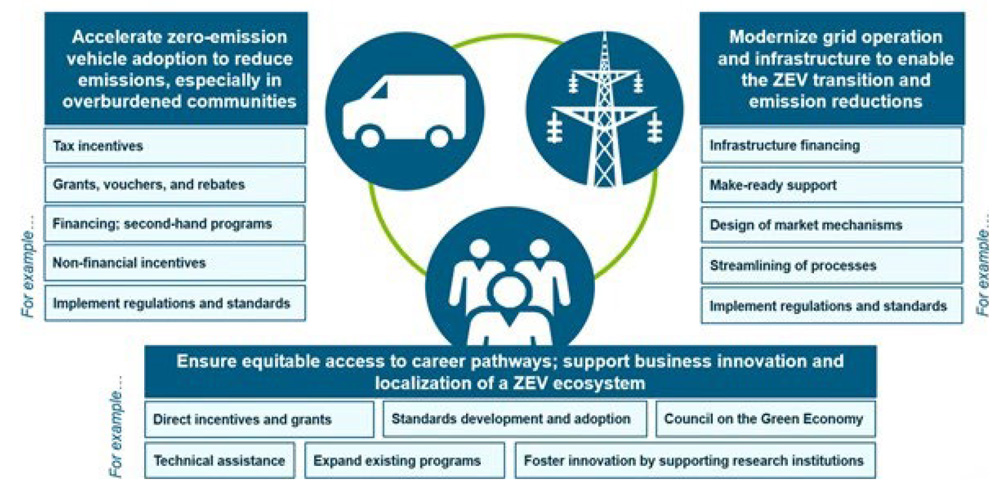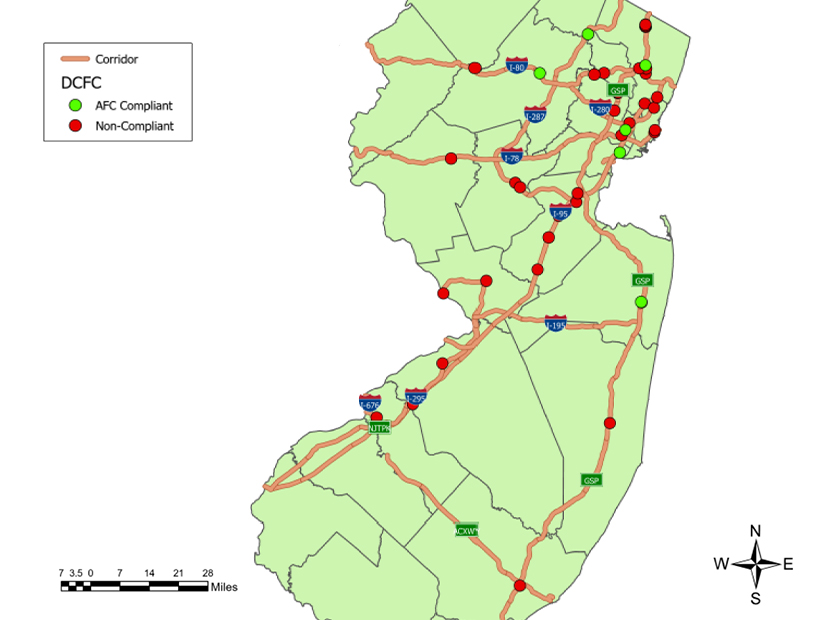New Jersey’s plan for spending $104 million in funds from the National Electric Vehicle Infrastructure (NEVI) program faced a barrage of stakeholder questions last week in the first hearings into how the state will meet a federal demand to line its highways with electric vehicle chargers within five years.
State transportation, energy and environmental officials, who presented the plan during virtual hearings on Dec. 13 and 15, are seeking stakeholder input to shape the final plan through a 17-page request for information released on Dec. 2. With more than 40 questions posed in the first session alone, responses suggest the state still has numerous issues to resolve as it seeks to tap into market interest.
One stakeholder wondered if the chargers would be located on government-owned or private land (the answer was “both”), while another questioned whether the locations depicted on a map were specific sites already assigned for charging stations or just identifying the areas of general need, leaving developers to find the specific location (the latter).
A third stakeholder asked whether developers bidding to install chargers must commit to maintaining them. Yes, for five years, said Andy Swords, director of the New Jersey Department of Transportation’s Division of Statewide Planning.
How about security for drivers stopped at charging stations, asked another stakeholder, who wanted to know if the state had set out “requirements” for developers to design sites in a way that would protect users.
“We have not developed specific requirements for security,” Swords answered, adding that those requirements would be in the solicitation when it comes out.
Stimulating EV Charger Development
The RFI is part of New Jersey’s effort to address the challenges facing states across the nation as they seek to put the flow of federal NEVI money to work creating a network of EV chargers that will jumpstart the — so far — relatively slow uptake of EVs.
For the initial round of NEVI funding, states are required to identify alternative fuel corridors (AFCs), major state and interstate highways where EV charging stations would be located every 50 miles. EVs can fully recharge in about an hour using the fast-charger ports now available.
The Biden administration in September approved EV charging plans for all states, starting the flow of the first $1.5 billion of NEVI money to put chargers along 75,000 miles of highway nationwide. The administration will eventually award $5 billion in NEVI funds. (See US Completes Review of State EV Charging Plans.)
The federal government initially allowed state transportation officials to be reimbursed for staffing and activities directly related to the development of charging plans. The funds can now be spent on a variety of related activities, including upgrading and adding EV charging infrastructure; operations and maintenance costs of charging stations; stakeholder engagement; workforce development; data sharing; and mapping analysis.
 Initial schedule for proposed implementation phases | State of New Jersey
Initial schedule for proposed implementation phases | State of New Jersey
Under the first phase of New Jersey’s NEVI plan, from 2022 to 2024, state officials will designate 12 highways as AFCs, among them two main arteries: the New Jersey Turnpike and Garden State Parkway. The state will use the funds to install four 150-kW chargers at least every 50 miles at locations less than a mile from the highway exit. (See NJ to Invest $10.8M in EV Chargers, School Buses.)
“NEVI requirements are that we have to build a set of fast-charging stations along interstate highways to achieve what’s called a fully built-out designation prior to being able to use that money in other in other locations,” Swords told stakeholders at the hearing. “So, once we have the fully built-out designation, then we can look at filling in the gaps along main roads and also with community charging.”
In the second phase, from 2023 to 2025, the state expects to focus on providing an even denser pattern of chargers with a goal of every 25 miles. In some cases, the state would look to increase funding efficiency by placing a charger at an intersection that serves two corridors, according to the plan.
The final phase, through 2026, would involve the installation of chargers that address other charging needs in the state.
“We plan to have flexible implementation of the funding based on community needs, which could include community-centric charging as well as fast-charging hubs near multiunit dwellings,” said Peg Hanna, assistant director of air monitoring and mobile sources at the Department of Environmental Protection.
One stakeholder asked how they could get a potential charger location site considered if it is in a low-income community and less than a mile from a highway.
“To the extent that the locations are consistent with NEVI requirements, they will be considered,” Swords said. “It’s possible that in New Jersey, given that it’s a densely populated state, there are communities very close to interstate highways. There may be cases where there are locations that meet those built-out requirements that also may be located in overburdened communities. And if that’s the case, they’re certainly eligible to be possible locations.”
Hanna added that the program’s bid evaluation criteria in selecting sites and projects gives additional weight to proposals for chargers located in environmental justice areas.
Revenue Share
New Jersey’s Energy Master Plan calls for the state to deploy 330,000 light-duty EVs by 2025, and state officials — as those in other states — believe a key to reaching that goal will be providing enough EV chargers to ensure drivers don’t fear their vehicle will run out of charge with no station nearby.
New Jersey is aiming to have 400 fast chargers and 1,000 Level 2 chargers in place by 2025. So far, the state has about 950 charger ports available, about a third of which are fast-charging and half are Level 2, according to the DEP’s Drive Green site. The department says about 95% of the state is within a 25-mile radius of a DC fast charger.
To help shape the state’s NEVI implementation, the RFI asks respondents, including potential applicants, to answer 17 questions. Among them are questions about how the state could maximize private investment in chargers, what could be the biggest barrier to installing chargers, and what respondents think of the state’s proposal to levy a “per site or per charger cap on available funds.”
 Whole of government approach to NJ’s EV ecosystem | State of New Jersey
Whole of government approach to NJ’s EV ecosystem | State of New Jersey
Other questions focus on respondents who plan to submit a bid to install chargers. The final questions ask about what respondents think is the best approach to workforce training and how they would address “clear risks in the current market environment,” such as “supply chain, labor availability and utility coordination issues.”
Swords noted that by increasing the use of EVs the state would reduce the number of gas-powered cars, reducing state gas tax revenues. That prompted one stakeholder to ask if the state is expecting a “revenue share for charging hosts” to make up for the lost.
“We’re just interested in ideas,” Swords said. “I wouldn’t go so far as to say we’re expecting a revenue share. However, we are very interested in hearing thoughts on this topic.”
Another stakeholder asked how the state anticipates the relationship between the charger host and its providing utility would work.
“First and foremost, the state of New Jersey sees [electric vehicle supply equipment] as a service, not a reselling of electricity,” said Cathleen Lewis, e-mobility program manager for the Board of Public Utilities. “So, the relationship between any of the electric companies and the and the station owner is that the station owner is responsible for paying for the electricity that they are utilizing.”
In addition, some utilities are offering incentives to charging stations, Lewis said.

